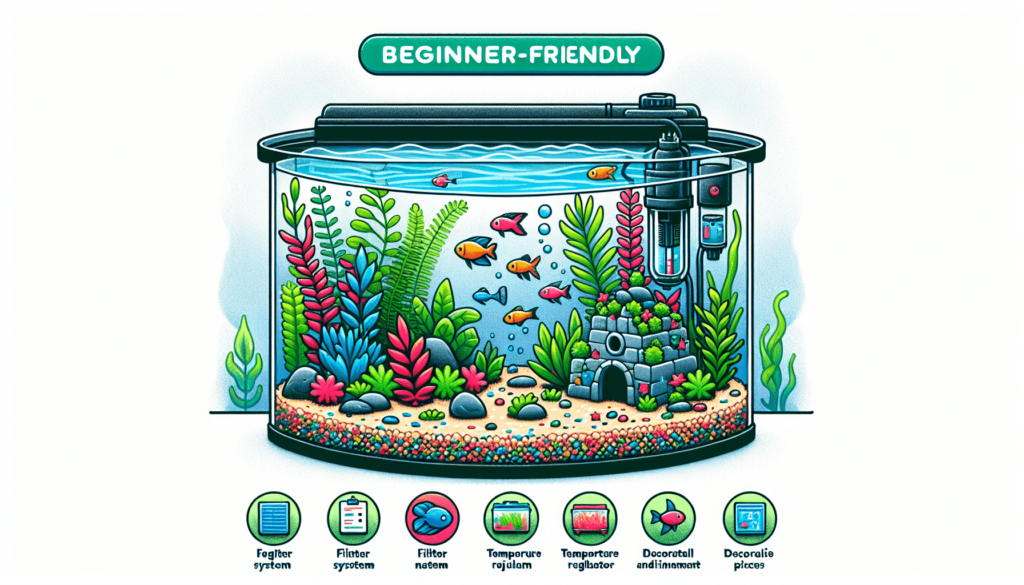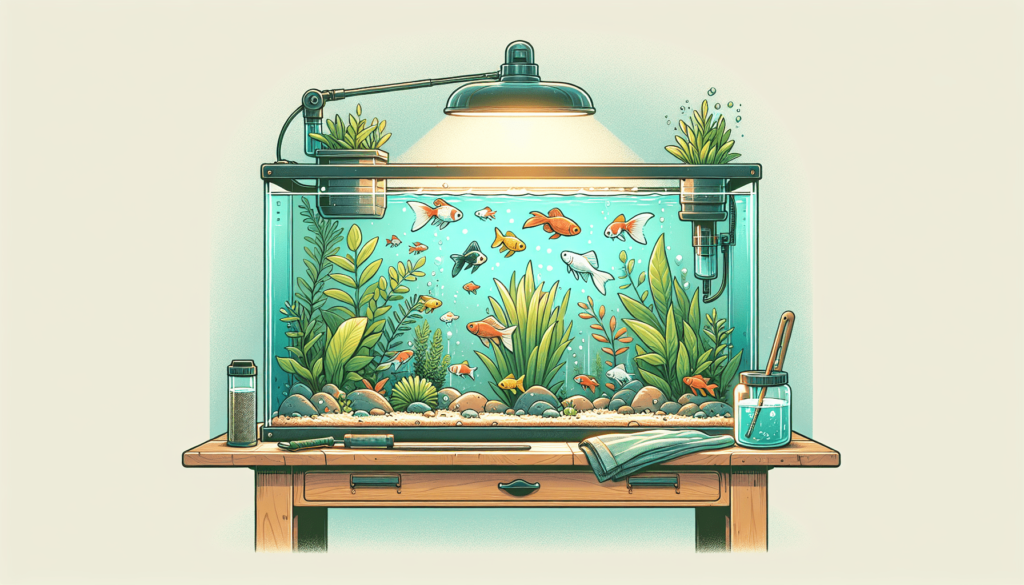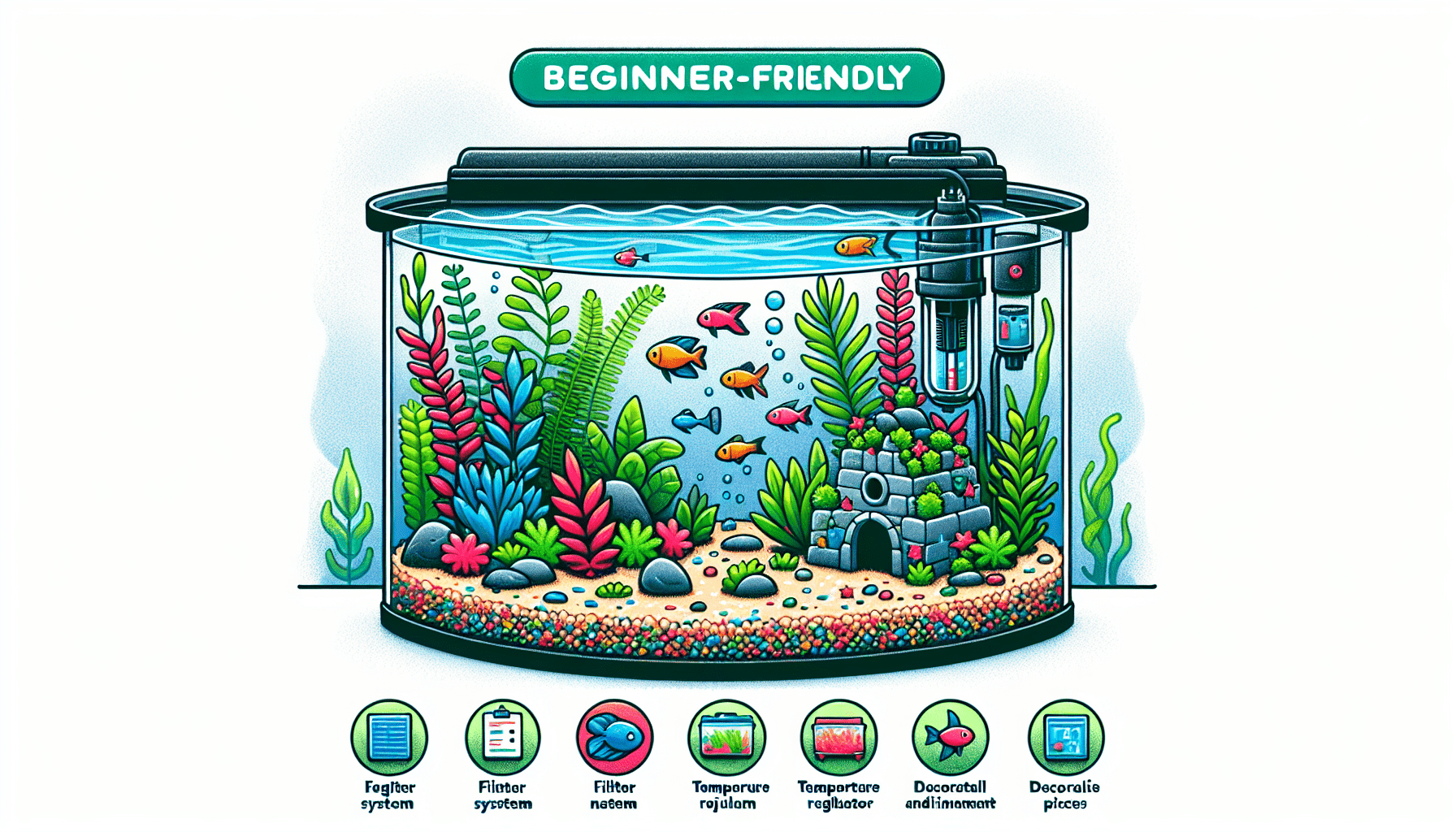So you’ve decided to embark on the exciting journey of starting your own fish tank, but you’re unsure about what size tank is best for beginners. Well, fear not! In this article, we will explore the various factors to consider when choosing the perfect fish tank size for beginners. From the space available in your home to the type of fish you want to keep, we’ll guide you through the process of finding the ideal tank size that will set you up for success in your new aquatic endeavor. So, let’s dive in and discover what size fish tank is best for beginners!

Factors to Consider
Available Space
When choosing a fish tank, the available space in your home is an important factor to consider. You need to make sure that you have a suitable area where you can place the tank. Measure the dimensions of the space and take note of any furniture or obstacles that may limit the size of the tank you can get. Remember that a fish tank requires a stable and level surface, so make sure that the area you choose can accommodate a tank of your desired size.
Budget
Another crucial factor to consider is your budget. Fish tanks come in a wide range of prices, so it’s important to determine how much you’re willing to spend. Keep in mind that there are additional costs involved with setting up and maintaining a fish tank, such as the cost of filters, heaters, decorations, and fish food. It’s important to allocate enough money not just for the initial tank purchase but also for the ongoing expenses.
Maintenance Time
Maintaining a fish tank requires time and effort. Consider how much time you’re willing to dedicate to the care and upkeep of your tank. Smaller tanks generally require more frequent water changes and cleaning compared to larger tanks. If you have a busy lifestyle, you may want to choose a tank size that requires less maintenance.
Fish Species
The type of fish species you plan to keep is another important factor to consider. Different fish have different space requirements and compatibility needs. Some fish, such as bettas, are fine in smaller tanks, while others, like goldfish, need larger tanks to thrive. Research the specific needs of the fish species you’re interested in and make sure that the tank size you choose is appropriate for them.
Popular Tank Sizes
10-Gallon Tank
A 10-gallon tank is a common choice for beginners due to its compact size. It’s suitable for keeping small fish or a single betta. However, it’s important to note that the small size of this tank means that it requires more frequent maintenance and may limit the number of fish you can keep.
20-Gallon Tank
A 20-gallon tank is a versatile option for beginners. It provides more space for fish and allows for a greater variety of species compared to a 10-gallon tank. With a 20-gallon tank, you can have a small community of fish and create a more interesting and dynamic aquarium.
30-Gallon Tank
If you have more space and a larger budget, a 30-gallon tank is a great choice. It provides ample space for fish to swim and interact, allowing for a more natural and visually appealing setup. With a 30-gallon tank, you can have a decent-sized community of fish with a greater variety of species.
40-Gallon Tank
For those looking to create a stunning centerpiece in their home, a 40-gallon tank is an excellent option. This larger tank allows for more fish and gives you the opportunity to create a beautiful underwater landscape with plenty of decorations and plants. A 40-gallon tank is ideal if you want to showcase a larger variety of fish and create a visually impactful aquarium.
Advantages of Different Sizes
10-Gallon Tank – Easy Maintenance
One advantage of a 10-gallon tank is that it is relatively easy to maintain. With a smaller volume of water, it requires less time and effort to perform water changes and clean the tank. It’s a good option for beginners who may not have much experience in fishkeeping or for those with limited time for maintenance.
20-Gallon Tank – More Fish Options
A 20-gallon tank offers more options when it comes to choosing fish species. It provides sufficient space to house a small community of fish, allowing you to create a more diverse and colorful aquarium. With a 20-gallon tank, you can have a combination of schooling fish, bottom-dwelling fish, and centerpiece fish, making your aquarium more interesting and visually appealing.
30-Gallon Tank – Ample Space for Fish
One of the advantages of a 30-gallon tank is the ample space it provides for fish to swim and explore. This extra space allows for a more comfortable and natural habitat for your fish, promoting their overall health and well-being. With a 30-gallon tank, you can create a lively and dynamic aquarium with a greater number of fish and more room for them to exhibit their natural behaviors.
40-Gallon Tank – Room for Decorations
A 40-gallon tank offers plenty of room for decorations, plants, and other aquarium accessories. It allows you to create a visually stunning display with a wide variety of plants, rocks, driftwood, and other decor items. The extra space also provides more hiding places for your fish, allowing them to feel secure and comfortable in their environment.
Recommended Tank Size for Beginners
20-Gallon Tank
For beginners, a 20-gallon tank is often the recommended starting point. It strikes a good balance between size, maintenance requirements, and variety of fish species. With a 20-gallon tank, you can create a beautiful and diverse aquarium while still being manageable in terms of maintenance. It provides enough space to accommodate different types of fish and allows you to learn the basics of fishkeeping without feeling overwhelmed.

Potential Challenges
Water Parameters
One common challenge for beginners is maintaining proper water parameters in their fish tank. Water temperature, pH levels, and ammonia and nitrate levels need to be carefully monitored and maintained within appropriate ranges for the specific fish species you have. It’s important to regularly test the water and make adjustments as needed to ensure a healthy environment for your fish.
Cleaning Challenges
Fish tanks, regardless of size, require regular cleaning to remove debris and maintain water quality. Smaller tanks, such as 10-gallon tanks, can require more frequent cleaning due to their smaller volume of water. It’s important to establish a regular cleaning routine and perform partial water changes to keep the tank clean and the fish healthy.
Limited Fish Species
In smaller tanks, such as 10-gallon tanks, the choice of fish species may be more limited compared to larger tanks. Some fish require more space to thrive and may not be suitable for smaller tanks. It’s essential to research the specific needs and requirements of the fish species you’re interested in and ensure that the tank size can accommodate them.
Tips for Maintaining a Beginner Fish Tank
Regular Water Testing
To ensure the health and well-being of your fish, it’s crucial to regularly test the water parameters in your tank. Test kits are available at pet stores and can measure parameters such as temperature, pH levels, and ammonia and nitrate levels. Regular testing will allow you to detect any issues early on and take corrective measures to maintain a stable and healthy environment for your fish.
Proper Cleaning and Water Changes
Regular cleaning and water changes are essential for maintaining good water quality in your fish tank. Remove any debris or uneaten food from the bottom of the tank and perform partial water changes to remove accumulated pollutants. Aim to change 10-20% of the water every 1-2 weeks, depending on the size of your tank and the number of fish you have.
Monitoring Fish Behavior
Keep a close eye on your fish’s behavior as it can be an indicator of their health and well-being. Healthy fish should be active, alert, and exhibit normal swimming and eating patterns. If you notice any changes in their behavior, such as lethargy, loss of appetite, or unusual swimming patterns, it could be a sign of a problem. Take immediate action and consult with a fish expert or veterinarian if needed.
Proper Feeding
Feeding your fish the right type and amount of food is crucial for their health. Different fish species have different dietary requirements, so research the specific needs of your fish and provide them with a balanced diet. Overfeeding can lead to poor water quality and health problems, so it’s important to feed your fish in moderation. Monitor their feeding habits and adjust the amount of food accordingly.
Conclusion
Choosing the right fish tank size for beginners involves considering various factors such as available space, budget, maintenance time, and fish species. While a 10-gallon tank may seem appealing for its compact size, a 20-gallon tank is often recommended as it provides more options for fish species and is easier to maintain. Remember to regularly test the water parameters, perform proper cleaning and water changes, monitor your fish’s behavior, and provide them with a balanced diet. With the right tank size and proper care, you can create a thriving and enjoyable aquarium for both you and your fish.

My name is James Gheen, and I am thrilled to welcome you to Tropical Fish Farmers, the ultimate destination for everything related to tropical fish breeding. As an avid underwater enthusiast, I am dedicated to sharing my knowledge and experience to help you successfully breed and care for tropical fish. Whether you’re a beginner starting your aquarium journey or a seasoned breeder looking to expand your knowledge, my website has something for everyone. Dive into our extensive library of articles, tutorials, and videos covering various topics to enhance your breeding success. Join me in our vibrant community and let’s contribute to responsible fish breeding and conservation efforts together. Discover Tropical Fish Farmers and become part of our global community today.

